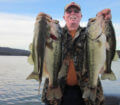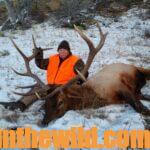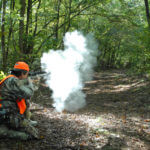Editor’s Note: Lake Guntersville (http://www.lakeguntersville.info/) is still kicking out monster bass, and anglers all across the country travel there to fish. In the first picture today, Phillip Criss, who guides on Guntersville Lake in north Alabama, is holding a 9-1/2-pounder that he caught mid-March, 2017. Criss fishes between 200 to 250 days a year on Lake Guntersville. If you throw in the number of days he fishes to find bass for his clients, he’s probably fishing 300 days per year. This week Criss will tell us the secrets to catching springtime Guntersville bass.
 When the lily pads appear on the surface of the water, they create shade, and shade prevents grass from growing on the bottom. The lily pads usually grow on hard bottom, and the hard bottom is where bass on Lake Guntersville prefer to spawn. The bass usually will bed in the lily pad stems. So in late March, the bass start moving into those stems, preparing their beds and waiting on the water temperature to get right for the spawn.
When the lily pads appear on the surface of the water, they create shade, and shade prevents grass from growing on the bottom. The lily pads usually grow on hard bottom, and the hard bottom is where bass on Lake Guntersville prefer to spawn. The bass usually will bed in the lily pad stems. So in late March, the bass start moving into those stems, preparing their beds and waiting on the water temperature to get right for the spawn.
When the water temperature stays 62 to 64 degrees for several days, I’ve learned that this is when the bass will spawn. Right now in mid-March, when I put my boat in the water, the water temperature is 54 to 56 degrees, but the water temperature often may reach 62 degrees except during the cold fronts our area had in mid-March. Although the water temperature isn’t a constant 62 degrees, the bass realize the time arrived for them to start pulling out of the deep water and begin looking for a place to spawn. They’ll usually search for spawning flats that are protected from a north wind. So, in April I’ll be fishing spawning regions protected from the north wind. Those areas generally will be 2-3 degrees warmer in the shallow water than the rest of the lake.
Normally, I won’t fish these places where we’ve caught bass due to the wind blowing into those spawning pockets. However, since the wind seems to be pushing the baitfish into the pockets, and the wind action puts more oxygen in those spawning pockets, the water temperature in those windy pockets will be 2-3 degrees warmer than the water on the main lake. I think the bass may have just been following the baitfish into the pockets where we’ve caught them. Traditionally, we see bedding bass here at Guntersville by the third week of March until the first week of April, if we don’t have any snow or cold fronts move onto the lake during this time.
 One of the tools I use to know where the bass should be every day I fish is a logbook. Each day when I come off the water from fishing, I log the conditions for that day, where I’ve found bass holding, and what lures we’ve used to catch those bass. I log where I’ve fished; the number and the size of bass I’ve caught; the time of the day that the bass bite best; and where they’ve seemed to be on their spawning cycle. I log how-many strikes I’ve had, and how-many bass we’ve had on our lines and lost, and the number of bass we’ve actually gotten to the boat, taken pictures of and released.
One of the tools I use to know where the bass should be every day I fish is a logbook. Each day when I come off the water from fishing, I log the conditions for that day, where I’ve found bass holding, and what lures we’ve used to catch those bass. I log where I’ve fished; the number and the size of bass I’ve caught; the time of the day that the bass bite best; and where they’ve seemed to be on their spawning cycle. I log how-many strikes I’ve had, and how-many bass we’ve had on our lines and lost, and the number of bass we’ve actually gotten to the boat, taken pictures of and released.
We usually don’t weigh every bass we catch. I’ve been looking at bass long enough that I can get pretty close to the actual weight of any bass that comes to the boat. Personally I think the way to really ruin a trip is to pull that scale out every time a customer catches a bass. If a customer catches a bass that he thinks weighs 5-6 pounds, I just say, “Yes, sir, that is a good one.” When someone catches a really-big fish, he or she usually wants to weigh and measure the bass, get pictures of fishermen with the bass and then release it.
My logbook will tell me about 75 to 80 percent of the time where we’ll find bass, which lures we need to catch the bass, and what time of day we’ll probably catch bass. Remember, on the days I’m not guiding customers, I’m out on the lake fishing places I’ve never fished before and using lures that I rarely if ever fish with, or that I’ve never fished with before. I also enter that information into my logbook.
Lake Guntersville averages 8 to10 tournaments held on the lake every weekend. During the month of March, 27 bass tournaments have been scheduled already to be held on Guntersville Lake – a tremendous amount of fishing pressure! In the next week or two, we’ll have the Big Bass Splash Tournament https://sealyoutdoors.com/enter-today-product_17al_3/ put on by Sealy Outdoors held on the lake with 3,000 to 3,500 entries. So, I have to know where the bass are holding, where they’re moving, what lures they’ll hit, where I can catch a bass with all that fishing pressure, and where the bass will go when a cold front hits. That’s why I tell people who want to fish Guntersville and have their best chance to catch a really-big bass to fish in the middle of the week, when there’s the least amount of fishing pressure, and the big bass are most likely to bite.
 The last day I fished in mid-March was a Friday before a Saturday when eight tournaments would be held on the lake. I saw eight to 10 boats fishing the pockets I wanted to fish. Yes, I could go in there and maybe catch a bass; but if I did, those eight to 10 boat anglers would see where I was fishing, and on what I was catching the bass. Then they’d move as close to me as they could. So, instead of pulling in the pockets with all the boats, I just went and pinpointed another place to fish. I have numbers of spots I can fish – even on the weekends. Then my anglers and I don’t have to fish in a crowd. This is another advantage that I have by keeping my daily log. However, having said that, I think I need to mention that you can catch a good bass any day of the week here at Guntersville Lake. However, the water is not nearly as disturbed in the middle of the week, and there won’t be nearly as many bass fishermen fishing in the middle of the week as on the weekends.
The last day I fished in mid-March was a Friday before a Saturday when eight tournaments would be held on the lake. I saw eight to 10 boats fishing the pockets I wanted to fish. Yes, I could go in there and maybe catch a bass; but if I did, those eight to 10 boat anglers would see where I was fishing, and on what I was catching the bass. Then they’d move as close to me as they could. So, instead of pulling in the pockets with all the boats, I just went and pinpointed another place to fish. I have numbers of spots I can fish – even on the weekends. Then my anglers and I don’t have to fish in a crowd. This is another advantage that I have by keeping my daily log. However, having said that, I think I need to mention that you can catch a good bass any day of the week here at Guntersville Lake. However, the water is not nearly as disturbed in the middle of the week, and there won’t be nearly as many bass fishermen fishing in the middle of the week as on the weekends.
Contact Phillip Criss on Lake Guntersville by calling 205-461-5549.
To learn more about bass fishing, get John E. Phillips’ Kindle eBooks, print books and audiobook on bass fishing, go https://johninthewild.com/books/#bass, or for Nook books, visit www.barnesandnoble.com.










